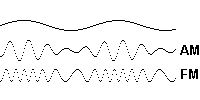Frequency modulation facts for kids
In telecommunications and signal processing, frequency modulation transmits information over a carrier wave by varying the frequency. This technique is different from amplitude modulation which varies the amplitude, but keeps the frequency constant. This kind of modulation is used in broadcasting and other radio work.
In the context of broadcasting, Frequency modulation is often shortened to FM. When transmitting analogue sound, the sound quality of FM signals is better than that of amplitude modulation (AM) signals. However, FM signals do not travel as far as AM beause they use higher frequencies that do not bounce off the Kennelly–Heaviside layer.
Many radio stations send out both kinds of signals. AM may be used for talk shows, and FM for music. FM broadcasting usually includes a difference signal, which can cause two different speakers at home to create different sounds. This creates stereo sound.
Images for kids
-
A signal may be carried by an AM or FM radio wave.
-
FM has better noise (RFI) rejection than AM, as shown in this dramatic New York publicity demonstration by General Electric in 1940. The radio has both AM and FM receivers. With a million-volt electric arc as a source of interference behind it, the AM receiver produced only a roar of static, while the FM receiver clearly reproduced a music program from Armstrong's experimental FM transmitter W2XMN in New Jersey.
-
Frequency spectrum and waterfall plot of a 146.52 MHz carrier, frequency modulated by a 1,000 Hz sinusoid. The modulation index has been adjusted to around 2.4, so the carrier frequency has small amplitude. Several strong sidebands are apparent; in principle an infinite number are produced in FM but the higher-order sidebands are of negligible magnitude.
See also
 In Spanish: Frecuencia modulada para niños
In Spanish: Frecuencia modulada para niños






